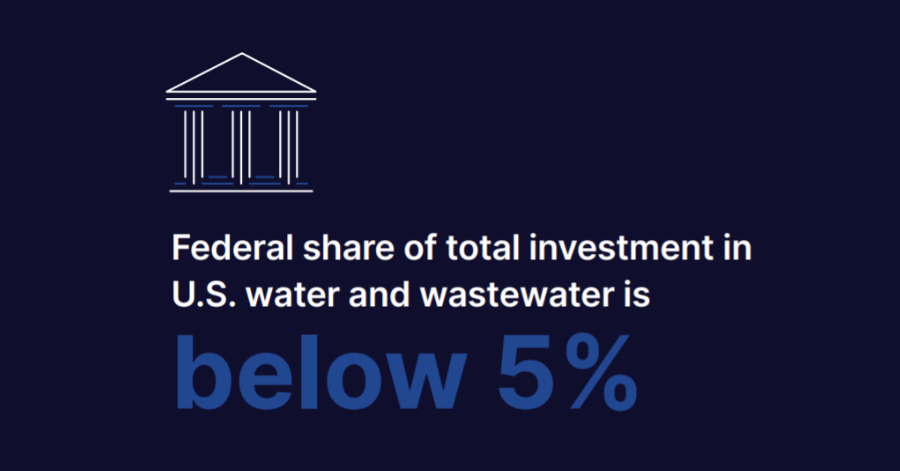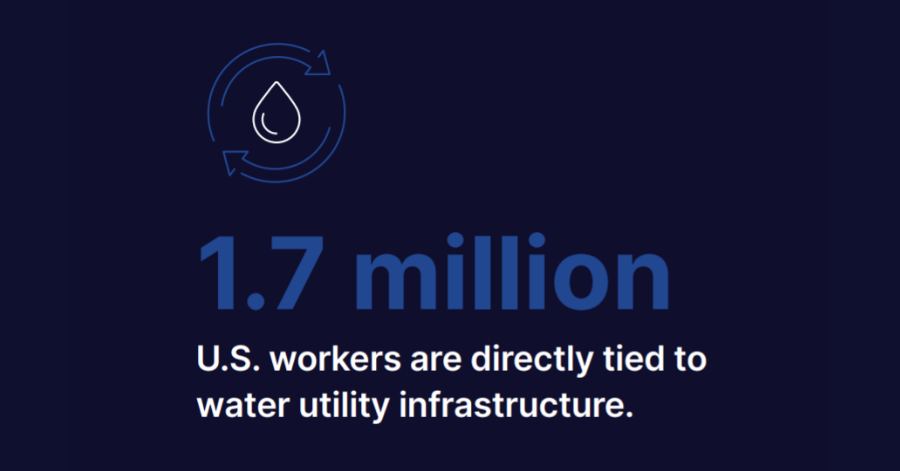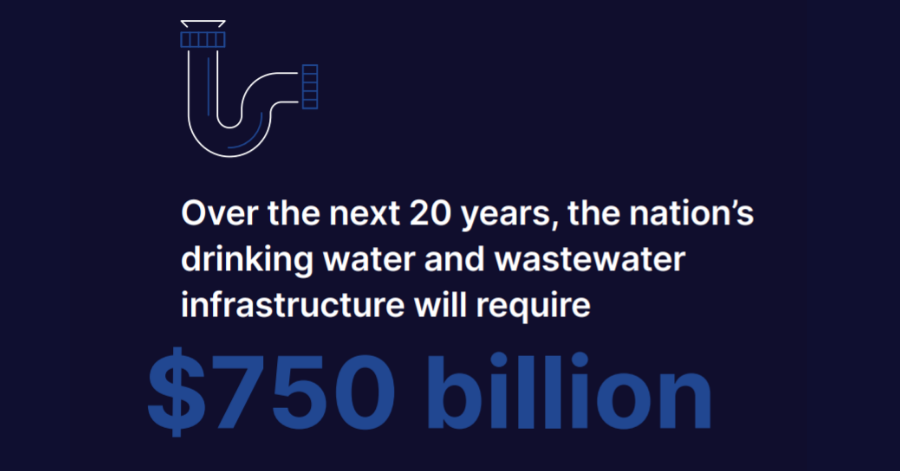Strong Federal Investment
A key foundation of American communities is the ability to provide safe, reliable, and affordable drinking and clean water services. The threat of coronavirus is reminding Americans of the vital importance of reliable water and wastewater services to mitigating the spread of disease.
But our nation’s wastewater, stormwater, and drinking water infrastructure are at a critical juncture and local communities are being called upon to do more with less to meet existing and growing challenges.
According to U.S. EPA estimates, the nation’s drinking water and wastewater infrastructure will require nearly $750 billion over 20 years just to maintain current levels of service. This does not include new costs such as addressing emerging contaminants, investing in resiliency, or innovating in areas such as water recycling to ensure safe and reliable local water supplies. Federal investments are critical to helping communities meet today’s needs and prepare for tomorrow’s challenges.
Significantly, the Congressional Budget Office finds that the federal share of total U.S. water and wastewater investment is currently below 5% — a much lower federal cost-share than other vital infrastructure sectors. Strengthening the federal partnership is essential to ensuring communities can provide vital water and wastewater services without over-burdening ratepayers.
 Evidence & Risk-Based Science
Evidence & Risk-Based Science
As stewards of our communities, the water sector strives each day to protect public health and the environment. We firmly believe that policies and regulations must be developed through an evidence and risk-based scientific and regulatory process that ensures complex water quality challenges, such as PFAS and other emerging contaminants, are properly addressed.
Research, Technology, & Innovation
The Clean Water Act and Safe Drinking Water Act have made vast improvements in environmental and public health over the past five decades. But as our nation’s water infrastructure ages and water quality and quantity challenges become more complex, stronger federal investment in water research and technological development is needed to spur innovative and cost-effective solutions and address new challenges.
Affordability
Across the U.S., many communities and their utilities are facing significant water affordability challenges, as rising rates for local water services disproportionately impact the poorest segments of these communities. The water sector is calling on U.S. EPA to revisit its financial capability guidance, and for the federal government to be a partner in addressing low-income water affordability issues.
 Workforce Development
Workforce Development
1.7 million U.S. workers are directly tied to water utility infrastructure. Over the next decade however, the water utility workforce is expected to incur a retirement rate of over one-third. Further federal support for water utility workforce is needed to prevent a shortage of skilled workers.
What Can Congress D0?
- Reauthorize the Clean Water State Revolving Fund (CWSRF) program and double the current funding level of $1.64 billion to $3.3 billion for FY2021. The CWSRF was established in 1987 to replace the Clean Water Construction Grants program. It has become a key financing tool providing more than $46 billion in federal capitalization grants which states have used to generate over $130 billion in clean water infrastructure projects nationally.
- Reauthorize and fund the Drinking Water State Revolving Fund (DWSRF) at an annual level not below its full FY21 authorization of $1.95 billion. From its establishment in 1996 through 2019, the DWSRF has generated more than $41billion in investment, helping cities and towns nationwide carry out nearly 16,000 projects to upgrade drinking water infrastructure, reduce public health risks, improve water supply sources, and modernize drinking water treatment.
- Support the USDA Rural Development Water & Wastewater Loan and Grant Program by providing $1.6 billion in loans and $600 million in grants in FY21. This program serves rural areas with populations of 10,000 or less.
- Reauthorize the Title XVI-WIIN Water Reclamation and Reuse Competitive Grants Program at $100 million per year, and provide at least $50 million in FY21. The program has been used to restore sensitive ecosystems, increase the supply of drinking water, generate sustainable irrigation water, and help industries create jobs. There are currently 56 Title XVI-WIIN eligible projects awaiting assistance, with a total of more than $700 million in eligible federal cost-share. This list will only grow as more projects become eligible.
- Reauthorize U.S. EPA’s Pilot Program for Alternative Water Source Grants at $75 million per year. This program would provide communities across the country the tools they need to improve water quality and enhance supplies.
- Reauthorize and provide increased funding for the Water Infrastructure Finance & Innovation Act (WIFIA) program. EPA’s FY20 appropriations legislation provided $55 million for WIFIA to leverage into as much as $11.5 billion worth of loans and loan guarantees for major drinking water and wastewater infrastructure projects.
- Reauthorize and provide increased funding for the U.S. EPA Sewer Overflow and Stormwater Reuse Municipal (“Section 221”) Grant program. This grant program was funded for the first time at $28 million in FY20 after being reauthorized in the 2018 WRDA package. The program targets a crucial void – federal grant dollars for clean water infrastructure – and we urge Congress to continue building this program in FY21.
- Provide $18 million for the U.S. EPA’s National Priorities Water Technical Assistance Program in FY21.
- Provide $20 million for the U.S. EPA National Priorities Water Research Grant Program in FY21. This grant program is the most important source of federal funding that directly supports extra-mural water research and technology development and deployment to help tackle our One Water research priorities.
- Reauthorize and increase funding for the Innovative Water Infrastructure Workforce Development Grants Program created in WRDA 2018. With the initial $1 million provided in FY20, U.S. EPA is standing up the program to provide workforce development assistance to utilities and communities.
- Ensure that local ratepayers and utilities do not bear the costs of remediating PFAS. Further, ensure that policies to analyze and regulate PFAS follow an evidence and risk-based assessment process as established in the Safe Drinking Water Act (SDWA) and Clean Water Act (CWA), and that EPA moves as expeditiously as possible in making its regulatory determinations.
- Help water systems prepare for climate and extreme weather challenges by reauthorizing EPA’s Drinking Water System Resilience and Sustainability Program, and expand eligibility to include all drinking water and wastewater systems nationwide.
- Ensure U.S. EPA updates its Affordability Guidance with a methodology that better assesses household affordability and community financial capability to more accurately reflect the true affordability of all water services.
- Through the coronavirus response packages, provide financial assistance to make utilities whole for providing water services regardless of ability to pay during the pandemic and to help mitigate lost revenues resulting from sharp, sudden declines in water use as businesses and industries shuttered.
- Provide strong funding for state drinking water and clean water programs including the Public Water System Supervision Grant and Clean Water Act Sec. 106 Grants. Federal funding for implementing the Safe Drinking Water Act and Clean Water Act are vital to protect public and environmental health.






Comments